Since different rods and different pistons are different weights, it is impossible to make a crankshaft that is balanced "right out of the box" for any rod and piston combination. All crankshafts must be balanced to your specific rod and piston combination.
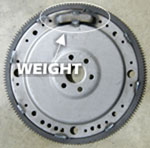 The first step in understanding crankshaft balancing is to understand the purpose of the counterweights. The counterweights are designed to offset the weight of the rod and pistons. You have the weight of the crankshaft and the pistons and rods. At any point in the assembly’s rotation, the sum of all of the forces are roughly equal to zero.
The first step in understanding crankshaft balancing is to understand the purpose of the counterweights. The counterweights are designed to offset the weight of the rod and pistons. You have the weight of the crankshaft and the pistons and rods. At any point in the assembly’s rotation, the sum of all of the forces are roughly equal to zero.
If the counterweights are the correct weight to offset the weight of the rods and pistons, the crankshaft is balanced. If the counterweights are too heavy, material must be removed by drilling or milling the counterweights. If the counterweights are too light, weight must be added to the counterweights. This is usually done by drilling a hole in the counterweight and filling the hole with "heavy metal" or "mallory". This filler metal is denser and heaver than steel (but not stonger) so the weight of the counterweight will increase as a result.
Internal Balance & External Balance
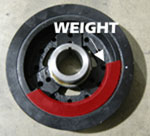 When the counterweights alone can be made to balance the crankshaft, the crank is said to be "internally balanced". If the counterweights are too light by themselves to balance the crankshaft and more weight is needed, an "external balance" can be used. This involves a harmonic dampener or flywheel that has a weight on it in the same position as the counterweight that effectively "adds" to the weight of the counterweight on the crankshaft.
When the counterweights alone can be made to balance the crankshaft, the crank is said to be "internally balanced". If the counterweights are too light by themselves to balance the crankshaft and more weight is needed, an "external balance" can be used. This involves a harmonic dampener or flywheel that has a weight on it in the same position as the counterweight that effectively "adds" to the weight of the counterweight on the crankshaft.
Since the harmonic dampener (front) or flywheel (rear) play a part in the balancing of the assembly, they must be installed on the crankshaft when it is balanced. This is unlike an internal balance configuration where the harmonic dampener or flywheel do not contribute to the balance of the crankshaft and are not required to be installed when the crankshaft if balanced. Both methods are used from the manufacturer.
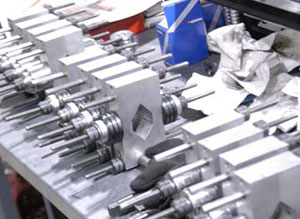 An example of some factory internally balanced engines are Chevy 305 and 350 (2 piece rear seal only!), Chevy 396/427, GM LS-series, and Ford "modular" 4.6. Some examples of factory externally balanced engines are Chevy 400 and 454, Ford 302 and 351W.
An example of some factory internally balanced engines are Chevy 305 and 350 (2 piece rear seal only!), Chevy 396/427, GM LS-series, and Ford "modular" 4.6. Some examples of factory externally balanced engines are Chevy 400 and 454, Ford 302 and 351W.
Some engines are a combination of both being internally balanced in the front and externally balanced in the rear. The most common example of this is the Chevy 350 (1 piece rear seal) including LT1. Regradless of how an engine is balanced from the factory any balancing method is acceptable as long as the required harmonic dampener and/or flywheel is available.
"Is my crank balanced?"
Since different rods and different pistons are different weights, it is impossible to make a crankshaft that is balanced "right out of the box" for any rod and piston combination. All crankshafts must be balanced to your specific rod and piston combination. When a crankshaft is listed as "internal balance" or "external balance" this is stating how this crank is intended to be balanced. It can be balanced otherwise, but it is much more difficult to do so.
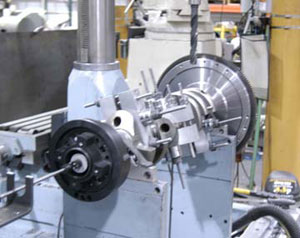 Eagle crankshafts, for example, are listed with a "target bobweight". This is an approximation (+/-2%) of the bobweight the crankshaft is roughly "out of the box". Because of the tolerance (+/-2%) the crankshaft cannot be considered balanced. For instance, for a crankshaft listed as having a 1800 target bobweight.
Eagle crankshafts, for example, are listed with a "target bobweight". This is an approximation (+/-2%) of the bobweight the crankshaft is roughly "out of the box". Because of the tolerance (+/-2%) the crankshaft cannot be considered balanced. For instance, for a crankshaft listed as having a 1800 target bobweight.
The actual range of bobweights one of those cranks might have is from 1764 (1800-2%) to 1836 (1800 +2%). It might even be at the high end of that range on one end and the low end of that range on the other! This is not usually a problem because Eagle crankshafts are designed to have a target bobweight higher than most typical rod and piston combinations. Therefore, in most cases you will only need to remove material to balance the crankshaft instead of adding material.
The main benefit of the target bobweight is to help the machine shop know what to expect before balancing so that a more accurate price estimate can be made. Eagle will balance a new crankshaft at the time of purchase. You will need to provide the bobweight you want it balanced to, which must be below the target bobweight listed for the crankshaft.
Bobweight
When a crankshaft is balanced, the actual rods and pistons cannot be used in the balancing machine, so they must be simulated. This simulated weight is called the "bobweight". Once the bobweight is calculated, weights are bolted onto the rod journals to simulate the weight of the rods and pistons during the balancing process. Due to the configuration of a "V" type engine, just adding all the weights together does not work.
There are also some dynamic considerations to be made when balancing the crankshaft. Explaining those is beyond the scope of this discussion. If you want to study those topics further, contact a crankshaft balancing machine manufacturer and they can go into greater detail.
To calculate the bobweight of a particular assembly, the following formula and balance card is used:
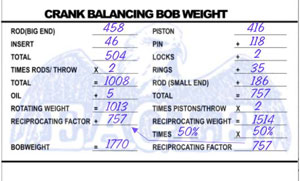
For example, let’s say we are balancing a Chevy 383 with the following component weights:
• Piston 416g
• Pin 118g
• Locks 2g
• Rings 35g
• Rod big end 458g
• Rod smal end 186g
• Bearings 46g
The rod weight is seperated into "big end" and "small end". This is necessary because the small end has a reciprocationg (back and forth) motion and the "big end" has a rotating motion. This split weight is figured on a special scale fixture that supports one end of the rod while weighing the other end.
There are several things to note about this calculation. The "oil" value used on the left side of the calculation is an approximation of the weight of residual oil "hanging around" on the assembly. The number used here is a matter of preference. There is no solid "rule of thumb" for this. Eagle uses 5g for small block assemblies and 15g for big block assemblies. Since it is impossible to accurately represent this value, it is just an estimate. The actual amount of oil can change constantly and can even be different from cylinder to cylinder! We have found through experience that the numbers we use estimate this property well.
The second thing to note is the 50% value used for the reciprocating factor. This number deals with the geometry of the engine itself. A 90 degree bank angle "V" engine will use 50% here. A V6 or a narrow or wide bank angle "V" engine will use a different value (again, consult the balancer manufacturer). Some engine builders will perform what is call "underbalancing" or "overbalancing". They will use slightly differnet values here such as 48% or 52%. This is done to help compensate for dynamic effects at extremely high or extremely low rpm operation (again, beyond the scope of this discussion). Eagle uses 50% because this value is required for almost all common street or racing engines.
Balanced Rotating Assemblies
Most Eagle rotating assemblies are sold unbalanced so that engine builders can balance it however they wish. Eagle (and other manufacturers) do offer fully balanced assemblies balanced. But it must be ordered specifically as a balanced assembly. Part numbers for balanced assemblies will begin with the letter B. For instance, if you want assembly part number 12006 balanced and in +.030" bore size, you would order assembly number B12006-030.
All Eagle forged 4340 steel crankshafts are designed for internal balance. An internally balanced kit will not include a harmonic dampener or flywheel because they are not required for balancing – use whatever brand you like. Externally balanced kits will include a harmonic dampener and/or flexplate as needed. If a harmonic dampener and flexplate is provided, it will be an O.E. style replacement, not SFI approved. If you’re building a high horsepower engine, internal balance is preferred. Internal balance is better for longevity of parts and fatigue life.
Technical Tip courtesy of Eagle Products (www.eaglerod.com)
